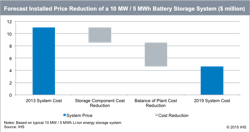Internet of Things Will Speed up Shift to Microgrids…and Other Quick Microgrid News
Better, smarter, faster microgrids are coming, according to recent analysis from Frost & Sullivan — but the capital required to implement the best-of-the-best is still a challenge for many communities.
“The emergence of the Internet of Things will strengthen communication channels between machines and minimize human intervention, thereby speeding up the shift to an integrated microgrid structure,” said TechVision research analyst Guhan Sriram R V. “The incorporation of predictive analysis will further bolster the reliability of the microgrid.”
Indeed, microgrids are becoming more efficient as sensors improve. Advanced batteries and super-capacitors — that is, better energy storage — will facilitate efficient distributed power flow. And the use of wide band gap semiconductor-based power electronics will deliver fast switching and better power handling capabilities — even as faster communication protocols for microgrids pave the way for better grid and source control.
“Microgrids would help bring in deregulation in power systems, thereby end an era of monopolized power sector in some regions. This will open the market to private energy providers, increase the competition, and bring down the cost of electricity,” noted Guhan.
***
The Air Force Research Laboratory (AFRL), in conjunction with the Hawaii Center for Advanced Transportation Technologies, will manage and facilitate a microgrid demonstration project at Joint Base Pearl Harbor-Hickam. When complete, it is expected to enable the Hawaii Air National Guard base to function independently of the power grid for extended periods of time, ensuring continuous flight and test operations even in the event of a disruption to the traditional power grid.
The project, a five-year, $20 million cooperative agreement, incorporates a number of energy-harvesting and storage technologies, including hydrogen vehicles and equipment, waste energy usage, wind power harvesting, and solar panels. It builds upon a previous cooperative agreement with AFRL that established advanced hydrogen production, and hydrogen-powered vehicles and equipment at the base.
The microgrid project fits well with Hawaii’s efforts to explore new, more accesible forms of energy. Hawaii Gov. David Ige recently committed the state to a 100 percent renewable energy standard by the year 2045 with the signing of four separate bills. Fuel costs are high in the island state, meaning the return on investment in alternative energies such as microgrids is much quicker.
***
Energy storage system prices have fallen significantly over the last few years, which is expected to broaden the global market, leading to more installations and deployments. According to the Grid-Connected Energy Storage Report from the IHS Energy Storage Intelligence Service, the average prices on lithium ion (li-ion) batteries fell 53 percent between 2012 and 2015. By 2019, they are forecast to again decline by half.
Storage inverters, power conversion systems (PCS) and other components will also experience significant competition in the coming years, and prices are expected to fall quickly. In fact, for a typical 30-minute duration utility-scale li-ion system, more than 60 percent of the total reduction in system costs between 2013 and 2019 will come from the balance-of-plant equipment, rather than from batteries alone.
“The breakdown of system costs, and the future evolution of prices, varies significantly depending on whether the system is configured to provide a high-power or high-energy application,” Wilkinson said, “but battery costs will continue to decline over the next five years.”
As battery storage system prices continue to fall, energy installations and deployments across the globe are expected to increase. with South Korea, Japan and the United States leading the way. These countries will each exceed a record 100 megawatts of annual energy storage installations this year, and they will account for 59 percent of global installations by 2016. Most other global markets remain in the test, pilot and demonstration phases, but deployment will increase in other regions in the next five years, according to IHS.
Got some microgrid news? Email [email protected], or read more Quick Microgrid News here.
